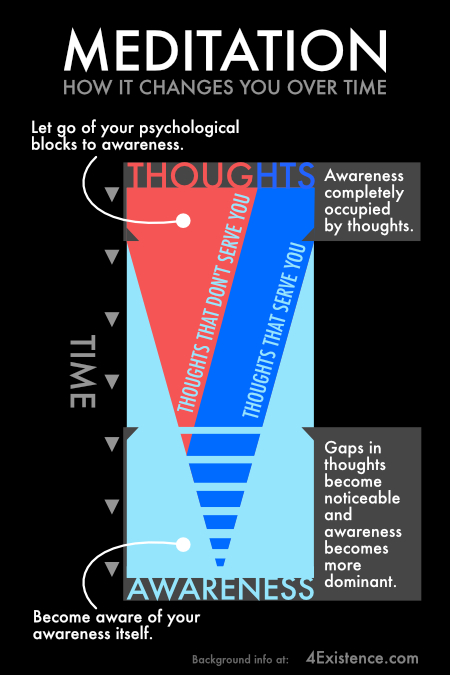
What is an effective meditation strategy – not a plan, schedule or routine, but a high-level strategy that will move you forward?
In order to have a strategy, you need to have a goal. What is your goal with meditation? Common answers are stress reduction and relaxation, focus and centeredness, more energy, better health, creativity, etc.
These are all wonderful byproducts of what is realized in an efficient meditation strategy, but they are not the goal. What is realized is the goal. What is realized is awareness itself – pure present moment awareness.
As you move toward the realization of awareness itself, or as you become aware of awareness itself, your mind will let go and relax, and you will receive the byproducts of stress-reduction, centeredness, energy, and everything else that meditation is hyped up to provide.
Typical Effective Meditation Progression
If we look at the process that people typically go through with an efficient meditation strategy, we could boil it down to 4 phases, and all of these phases can overlap.
- Learning to be attentive in meditation, which prepares you for the following phases 2 and 3.
- Learning to become aware of your awareness itself, and letting go of your psychological blocks to awareness.
- Resting in pure awareness, and experiencing an identity shift from thoughts governing your experience to awareness itself as the forefront of your experience.
- Pure awareness is your experience and you no longer feeling a need to meditate.
To have an efficient strategy, you want to align your meditation practices with these phases based on where you honestly think you are in the process.
Types of Meditation to Meet Your Needs
The following types of meditation can be applied based on your self-determined status:
1. Meditations to Learn to Be Attentive (examples):
-
- Noticing and counting your breath (find an example of this type of breath meditation in this post)
- Watching thoughts arise and pass
2. Meditations to Learn To Become Aware of Awareness Itself (examples):
-
- Be aware of what is observing your breath.
- Be aware of what is observing the senses and feelings in your body come and go.
- Be aware of what is observing your thoughts come and go.
- Be aware of what observes awareness itself.
- How To Find Yourself Through Awareness of Awareness
- Meditation for Awareness, 3 Excellent Awareness Meditations
3. Meditations to Learn To Let Go of Your Psychological Blocks to Awareness (example):
-
- Notice negative thoughts and associated emotions as feelings or sensations in your body, ask the feeling or sensation what it is trying to tell you.
- Wait and allow the answer to arise – don’t try to think of the answer.
- Ask calmly and repetitively if you need to.
- Follow the negative emotion to its roots of fear.
- Find out what you are thinking falsely about the fear and allow the fear to be there and to pass.
- Dig deeper into this approach here
These three types of meditation, or any combination thereof, can be done in the same meditation session. Meditation for building attention can prepare you for becoming aware of your awareness (2) or for letting go of your psychologic blocks (3). The latter two (2 and 3) beget one another.
Your Meditation Strategy
From a higher level, determine where you are with your meditation practice and on a given day, decide what type or types to focus on.
For example, today you might be feeling emotional, so you’ll want the emphasis to be on the third type above “Letting Go of Psychological Blocks to Awareness”. Another day you might feel very at peace and you’ll want to just rest in awareness meditation described in the second type above. If you’re having trouble with focusing long enough to do number 2 or 3, then spend some type on the first type to become more attentive.
If you are the type that needs a rigid approach to meditation, that is ok, you can make it rigid if you need to, but at least do it with an overall strategy in mind, and I recommend the strategy above.
It can be helpful to not be so rigid. So if you are, make that part of your strategy. In other words, over time, try to loosen up your rigidness. This is part of letting go, which in itself is important during any given meditation. The relaxation that letting go leads to helps you follow your intuition to determine if or when to meditate on a given day, and what type or types of meditation to do.
This fluid approach to meditation can be very helpful to make your meditation practice as efficient as possible because you are answering what you naturally feel you need to move forward.
Meditation Strategy Outside of Formal Meditation
You can also convert the meditation types described above to techniques that you can do outside of meditation in your daily functional life, and this will help improve your meditation practice when you want to do it formally.
For example, if you find yourself getting angry about something at work or home, you can note it to address in meditation later through the 3rd type above. Alternatively, you can address it through stream-of-consciousness writing and journaling to explore the issue to its roots and let it go.
You can also take any opportunity throughout your day to check in with your own awareness by occasionally and habitually asking yourself if you are aware right now. This question brings you into the present moment and makes you aware of your own awareness.
How An Efficient Meditation Strategy Changes You Over Time
The following infographic will give you an idea of how you meditation can change you over time. Note that this depicts a typical and generalized progression based on personal experience, anecdotal feedback from others, and reports of experiences from meditation from a wide range of resources.

By using the strategy described here, you will be letting go of your psychological blocks to awareness and becoming aware of your awareness itself over time. This change can also happen within a given meditation, but it may not last once you finish the session. That’s ok. Just keep to the strategy over time and you will begin to notice changes in your experience and life.
As awareness comes to the forefront of your experience, you will notice changes in how you respond emotionally and behaviorally to things that used to trigger you negatively. You will also notice all kinds of other benefits.
Get More Help With Meditation Strategy
Join my free “Key To Meditation” email program to learn how to become aware of your awareness itself, let go of your psychological blocks to awareness, and get the most out of your meditation practices: The Key To Meditation. Also, learn more about How To Meditate Properly